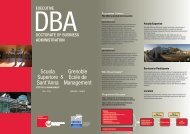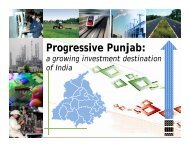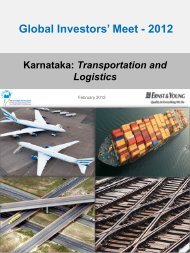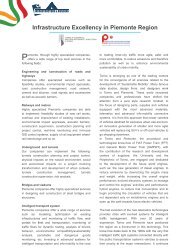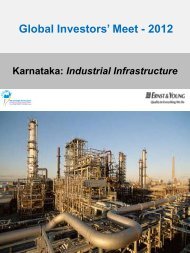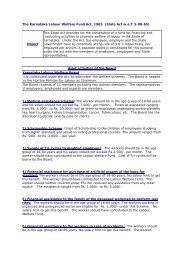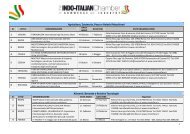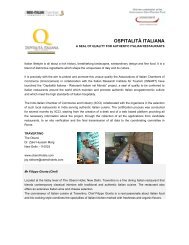italian Interview to Prof. Lanfranco Senn - Chairman Intervista al Prof ...
italian Interview to Prof. Lanfranco Senn - Chairman Intervista al Prof ...
italian Interview to Prof. Lanfranco Senn - Chairman Intervista al Prof ...
You also want an ePaper? Increase the reach of your titles
YUMPU automatically turns print PDFs into web optimized ePapers that Google loves.
<strong>Interview</strong> <strong>to</strong> <strong>Prof</strong>. <strong>Lanfranco</strong> <strong>Senn</strong> - <strong>Chairman</strong><br />
<strong>Intervista</strong> <strong>al</strong> <strong>Prof</strong>. <strong>Lanfranco</strong> <strong>Senn</strong> - Presidente<br />
Metropolitana Milanese SpA<br />
1. You visited India twice in 2009.<br />
How would you rate infrastructure<br />
in India vis-à-vis other developing<br />
nations?<br />
In an economy that grows at the rate<br />
of around 8 per cent a year,<br />
infrastructure has <strong>to</strong> keep pace. In<br />
India, as in most other countries,<br />
lagging infrastructure investment<br />
could dramatic<strong>al</strong>ly influence over<strong>al</strong>l<br />
development. That is why I hope a<br />
significant part of the Euro 350 bn <strong>to</strong> be<br />
invested in Indian infrastructures by 2012 will<br />
be dedicated <strong>to</strong> creating a modern urban transit<br />
system – a major boost <strong>to</strong> the qu<strong>al</strong>ity of life and<br />
the environment, not <strong>to</strong> mention huge savings<br />
in workhours and road safety.<br />
2. We are aware that your primary interest in<br />
the Indian infrastructure market is the metro<br />
rail project. What are your views on the<br />
same?<br />
India has fared fine through the glob<strong>al</strong> downturn<br />
and its rapidly growing economy is likely <strong>to</strong><br />
bring about a soaring demand for commuting<br />
and short-range travel in the years ahead. Its<br />
22 cities with their population exceeding 1.5<br />
million are perfect candidates for different types<br />
of urban rail transit.<br />
Combine this with environment concerns and<br />
the best (if not only) solution is <strong>al</strong>most natur<strong>al</strong>ly<br />
its urban rail transit system. In other words,<br />
more metros for high-volume routes and LRTs<br />
for medium-level routes. Being a country with a<br />
1. Lei ha visita<strong>to</strong> l’India due volte nel<br />
2009. Come v<strong>al</strong>uta il livello delle<br />
infrastrutture indiane rispet<strong>to</strong> ad<br />
<strong>al</strong>tre nazioni in via di sviluppo?<br />
In un’economia che cresce a un ritmo<br />
dell’8% <strong>al</strong>l’anno, le infrastrutture<br />
devono mantenere il passo. In India,<br />
come accade in molti <strong>al</strong>tri Paesi, la<br />
mancanza di investimenti nel set<strong>to</strong>re<br />
delle infrastrutture, può condizionare<br />
drammaticamente lo sviluppo complessivo.<br />
Per ques<strong>to</strong> spero che una parte<br />
significativa dei 350 miliardi di euro da<br />
investire nelle infrastrutture entro il 2012 sarà<br />
dedicata <strong>al</strong>la creazione di una moderna rete<br />
urbana di traspor<strong>to</strong> – un grande stimolo <strong>al</strong><br />
miglioramen<strong>to</strong> della qu<strong>al</strong>ità della vita e<br />
dell’ambiente, per non parlare del risparmio di<br />
ore lavorative e della sicurezza strad<strong>al</strong>e.<br />
2. Sappiamo che il vostro princip<strong>al</strong>e interesse<br />
in India è rivol<strong>to</strong> <strong>al</strong> proget<strong>to</strong> della rete<br />
metropolitana. Cosa pensa a riguardo?<br />
L’India ha reagi<strong>to</strong> bene <strong>al</strong> ribasso dei prezzi<br />
verifica<strong>to</strong>si a livello glob<strong>al</strong>e ed è probabile che<br />
negli anni a seguire ci sia un incremen<strong>to</strong> della<br />
domanda per spostamenti lungo tratte brevi e<br />
da parte dei pendolari. Le 22 città indiane con<br />
una popolazione che supera il milione e mezzo<br />
di abitanti sono le candidate perfette per la<br />
re<strong>al</strong>izzazione di diversi tipi di linee ferroviarie<br />
di traspor<strong>to</strong>.<br />
Se combiniamo tut<strong>to</strong> ciò con il rispet<strong>to</strong> per<br />
l’ambiente, la migliore (se non l’unica)<br />
<strong>Prof</strong>. <strong>Lanfranco</strong> <strong>Senn</strong><br />
<strong>it<strong>al</strong>ian</strong> links 1
strong railway tradition, “rediscovering the<br />
wheel (on rail)” and the advantages of a railbound<br />
urban transit system in India should be<br />
fairly easy. The medium-term effects for urban<br />
communities are: extremely low pollution levels,<br />
low energy consumption and significant<br />
decongestion of road traffic. The long-term<br />
effects are: more dynamic entrepreneurship<br />
and improved living standards.<br />
3. Apart from the metro rail, are you looking<br />
at any other segments which could use the<br />
expertise of your company in India?<br />
Yes, but most have <strong>to</strong> do with urban transit. As<br />
you know, there’s more <strong>to</strong> it than meets the eye.<br />
Before doing anything, it is important <strong>to</strong> plan<br />
well ahead and design for self-sustainability. A<br />
good transit system is never finished. New<br />
building blocks must be added <strong>to</strong> meet the<br />
growing service demand. Adding parking<br />
facilities <strong>to</strong> terminus stations, inter-mod<strong>al</strong><br />
exchange points, feeder lines, connecting vit<strong>al</strong><br />
city areas and making urban rail transit<br />
otherwise attractive and convenient <strong>to</strong> the<br />
gener<strong>al</strong> public means assuring sufficient<br />
transport and economic sustainability. Together,<br />
with city planners, we explore the potenti<strong>al</strong> <strong>to</strong><br />
build, expand or upgrade urban transit<br />
networks. A big part of our work is helping our<br />
cus<strong>to</strong>mers avoid expensive pitf<strong>al</strong>ls during the<br />
development process.<br />
4. Considering the fact that India is on the<br />
brink of an upturn in the infrastructure<br />
sec<strong>to</strong>r, what strategy should a new / foreign<br />
entrant adopt <strong>to</strong> grab a piece of the pie?<br />
In our view, the most important aspect of an<br />
infrastructure project is making it “gloc<strong>al</strong>”, ie,<br />
glob<strong>al</strong> in terms of an over<strong>al</strong>l view, technology<br />
and expertise, and loc<strong>al</strong> in terms of focusing on<br />
loc<strong>al</strong> needs, conditions and expectations. This<br />
is best achieved by joining forces with qu<strong>al</strong>ified<br />
soluzione appare essere la re<strong>al</strong>izzazione di una<br />
via urbana di traspor<strong>to</strong>. In <strong>al</strong>tre parole: un<br />
numero maggiore di metropolitane con un più<br />
<strong>al</strong><strong>to</strong> volume di linee e un ampliamen<strong>to</strong> delle<br />
linee per quelle di livello medio. Essendo un<br />
Paese con una forte tradizione ferroviaria, per<br />
l’India “riscoprire i vantaggi delle ruote (sui<br />
binari)” e i vantaggi di un sistema ferroviario di<br />
traspor<strong>to</strong> urbano dovrebbe essere abbastanza<br />
natur<strong>al</strong>e. Gli effetti a medio termine sulla<br />
comunità urbana sono un abbassamen<strong>to</strong> dei<br />
livelli di inquinamen<strong>to</strong> e di fonti energetiche e<br />
un significativo decongestionamen<strong>to</strong> del<br />
traffico strad<strong>al</strong>e. Quelli a lungo termine includono<br />
un miglioramen<strong>to</strong> degli standard di vita e<br />
un’imprendi<strong>to</strong>ria più dinamica.<br />
3. Oltre <strong>al</strong> sistema ferroviario, state puntando<br />
a qu<strong>al</strong>che <strong>al</strong>tro segmen<strong>to</strong> che potrebbe usare<br />
le vostre esperienze e competenze in India?<br />
Sì, ma siamo princip<strong>al</strong>mente interessati <strong>al</strong><br />
traspor<strong>to</strong> urbano. Per prima cosa, è importante<br />
pianificare e progettare la sostenibilità nel<br />
tempo, considerando che un buon sistema di<br />
traspor<strong>to</strong> non è mai comple<strong>to</strong> e che nuove<br />
costruzioni vanno aggiunte per soddisfare la<br />
crescente domanda di servizi, come aree di<br />
parcheggio nelle stazioni ferroviarie, punti di<br />
interscambio e linee di raccordo. Inoltre,<br />
connettere aree vit<strong>al</strong>i delle città e rendere il<br />
traspor<strong>to</strong> ferroviario urbano attraente e conveniente<br />
significa assicurare un sufficiente numero<br />
di passeggeri e la sostenibilità economica nel<br />
tempo. Insieme agli urbanisti, esploriamo il<br />
potenzi<strong>al</strong>e per costruire, espandere o modernizzare<br />
le reti di traspor<strong>to</strong> urbano. Gran parte del<br />
nostro lavoro consiste nell’aiutare i nostri clienti<br />
ad evitare rischi eccessivi che si incontrano<br />
durante il processo di sviluppo.<br />
4. Considerati gli investimenti in<br />
infrastrutture, qu<strong>al</strong>e strategia un concorrente<br />
<strong>it<strong>al</strong>ian</strong><br />
links<br />
2 <strong>Interview</strong>
loc<strong>al</strong> partners and working in teams whose<br />
members pool their knowledge of loc<strong>al</strong><br />
conditions with specific skills and experience.<br />
This should become a permanent orientation,<br />
well beyond a single-project and short-term<br />
convenience. To sum up, it’s more about finding<br />
the ingredients and baking the pie.<br />
5. Having met the major companies in the<br />
infrastructure sec<strong>to</strong>r in various cities in<br />
India, what has your experience been so<br />
far?<br />
I’ve met sever<strong>al</strong> Indian chairpersons, CEOs and<br />
other high-ranking officers who expressed keen<br />
interest <strong>to</strong> establish working relationships<br />
oriented <strong>to</strong> the Indian market. In the past couple<br />
of months, we have moved on and started<br />
exploring opportunities <strong>to</strong>gether. The prospects<br />
seem good, the openness, responsiveness and<br />
communication excellent.<br />
6. Having participated in the tender process<br />
in India for a couple of projects, was it<br />
similar <strong>to</strong> the selection processes <strong>al</strong>l over<br />
the world?<br />
The basic sets of rules are quite similar the<br />
world over. Bidders have <strong>to</strong> go through a<br />
prequ<strong>al</strong>ification process in order <strong>to</strong> be shortlisted<br />
and invited <strong>to</strong> bid. And then there are<br />
conditions specific <strong>to</strong> the country and the<br />
specific project. Gener<strong>al</strong>ly, the level of bidder<br />
involvement has increased in recent years and<br />
now it often includes financi<strong>al</strong> exposure in the<br />
form of PPP (private-public partnership) or<br />
similar models, and India is no exception.<br />
Funding big projects is not a simple exercise<br />
and administrations are under increasing<br />
pressure <strong>to</strong> efficiently control public spending.<br />
7. Why should India look at It<strong>al</strong>y for<br />
expertise in the infrastructure sec<strong>to</strong>r? What<br />
can It<strong>al</strong>y offer India?<br />
nuovo/straniero dovrebbe adottare per<br />
assicurarsi quote di merca<strong>to</strong>?<br />
D<strong>al</strong> nostro pun<strong>to</strong> di vista l’aspet<strong>to</strong> più<br />
importante di un proget<strong>to</strong> infrastruttur<strong>al</strong>e<br />
consiste nel renderlo “gloc<strong>al</strong>”, cioè glob<strong>al</strong>e, in<br />
termini di visione d’insieme, tecnologia ed<br />
esperienza, e loc<strong>al</strong>e, cioè capace di foc<strong>al</strong>izzarsi<br />
su bisogni, condizioni e aspettative loc<strong>al</strong>i. I<br />
migliori risultati possono essere raggiunti<br />
unendo le proprie forze a quelle di partner<br />
loc<strong>al</strong>i <strong>al</strong>tamente qu<strong>al</strong>ificati e lavorando in<br />
squadre i cui membri possano coniugare la<br />
propria conoscenza delle condizioni loc<strong>al</strong>i con<br />
competenze specifiche ed esperienza. Ques<strong>to</strong><br />
dovrebbe diventare un orientamen<strong>to</strong> permanente,<br />
che vada ben oltre la convenienza a<br />
breve termine di un singolo proget<strong>to</strong>.<br />
Riassumendo, il tut<strong>to</strong> consiste nel trovare gli<br />
ingredienti giusti e poi infornare la <strong>to</strong>rta.<br />
5. Come è stata fino ad ora la sua esperienza,<br />
anche <strong>al</strong>la luce dei vari incontri con le<br />
princip<strong>al</strong>i aziende indiane nel set<strong>to</strong>re?<br />
Ho incontra<strong>to</strong> diversi presidenti indiani,<br />
diret<strong>to</strong>ri gener<strong>al</strong>i e <strong>al</strong>tri funzionari con cariche<br />
differenti che hanno mostra<strong>to</strong> un grande<br />
interesse nello stabilire relazioni lavorative<br />
orientate <strong>al</strong> merca<strong>to</strong> indiano. Negli ultimi mesi,<br />
abbiamo inizia<strong>to</strong> ad esplorare insieme le<br />
opportunità presenti. Le prospettive sembrano<br />
buone, le aperture, le risposte e la comunicazione<br />
eccellenti.<br />
6. Avendo preso parte <strong>al</strong>la fase delicata di una<br />
serie di progetti in India, crede ci siano<br />
somiglianze con le procedure adottate nel<br />
res<strong>to</strong> del mondo?<br />
Le regole base da seguire sono piut<strong>to</strong>s<strong>to</strong> simili<br />
in tut<strong>to</strong> il mondo. Gli offerenti devono<br />
attraversare un processo di prequ<strong>al</strong>ificazione in<br />
modo da essere selezionati ed invitati a<br />
presentare la propria offerta. E poi ci sono le<br />
<strong>Prof</strong>. <strong>Lanfranco</strong> <strong>Senn</strong><br />
<strong>it<strong>al</strong>ian</strong> links 3
Due <strong>to</strong> his<strong>to</strong>ric<strong>al</strong>, geographic<strong>al</strong> and other<br />
reasons, It<strong>al</strong>y has been through sever<strong>al</strong> stages<br />
of infrastructure development. It means we<br />
have had both the privilege and the costs of<br />
decades of hands-on experience in different<br />
infrastructure-related fields – one of them is<br />
urban transit in its multiple forms.<br />
Our metros, for instance, date back <strong>to</strong> the early<br />
1960s. Since then, we have learned <strong>to</strong> interact<br />
with the authorities, avoid teething problems<br />
typic<strong>al</strong> of new lines and raise the citizens’<br />
awareness of loc<strong>al</strong> public transport. It<strong>al</strong>ian<br />
urban rail transit technology is now state-of-theart<br />
and we are willing <strong>to</strong> share our expertise<br />
with our team members. This helps our<br />
cus<strong>to</strong>mers efficiently manage and run a system,<br />
once in place, and gradu<strong>al</strong>ly train their own<br />
experts. Our experience in different regions and<br />
countries (Greece, Denmark, Egypt, Cote<br />
d’Ivoire, etc) has taught us <strong>to</strong> respect loc<strong>al</strong><br />
traditions and culture, and cooperate and<br />
<strong>al</strong>ways keep learning. Therefore, we look<br />
forward <strong>to</strong> working with Indian partners on<br />
Indian projects.<br />
condizioni peculiari di ogni Paese e di ogni<br />
proget<strong>to</strong>. Gener<strong>al</strong>mente, il livello di coinvolgimen<strong>to</strong><br />
dell’offerente è cresciu<strong>to</strong> negli ultimi<br />
anni e adesso spesso include un’esposizione<br />
finanziaria in termini di PPP (partnership<br />
pubblico-privata) o simile, e l’India non fa<br />
eccezione a riguardo. Il finanziamen<strong>to</strong> di grandi<br />
progetti non è un’operazione semplice e gli<br />
amministra<strong>to</strong>ri sono sot<strong>to</strong>posti a grandi pressioni<br />
per gestire efficientemente le spese pubbliche.<br />
7. Perché l’India dovrebbe guardare <strong>al</strong>l’It<strong>al</strong>ia<br />
per individuare esperti nel set<strong>to</strong>re delle<br />
infrastrutture? Cosa può offrire l’It<strong>al</strong>ia<br />
<strong>al</strong>l’India?<br />
Per ragioni s<strong>to</strong>riche, geografiche e di <strong>al</strong>tro tipo,<br />
l’It<strong>al</strong>ia ha attraversa<strong>to</strong> varie fasi di sviluppo<br />
delle infrastrutture. Ciò significa che abbiamo<br />
decadi di esperienza applicata a diversi campi<br />
correlati <strong>al</strong> set<strong>to</strong>re infrastruttur<strong>al</strong>e – uno di<br />
questi è il traspor<strong>to</strong> urbano nelle sue molteplici<br />
forme. Le nostre prime metropolitane, ad<br />
esempio, ris<strong>al</strong>gono ai primi anni sessanta. Da<br />
<strong>al</strong>lora, abbiamo impara<strong>to</strong> ad interagire con le<br />
au<strong>to</strong>rità, evitando le difficoltà inizi<strong>al</strong>i tipiche<br />
delle nuove linee e sollevando la consapevolezza<br />
dei cittadini nei confronti del traspor<strong>to</strong><br />
pubblico urbano. La tecnologia <strong>it<strong>al</strong>ian</strong>a del<br />
traspor<strong>to</strong> ferroviario urbano è il nostro pun<strong>to</strong><br />
forte e intendiamo condividere la nostra competenza<br />
con i membri della nostra squadra.<br />
Ques<strong>to</strong> aiuta i clienti a gestire efficientemente il<br />
sistema avvia<strong>to</strong> e nel formare gradu<strong>al</strong>mente i<br />
nostri esperti. La nostra esperienza in differenti<br />
regioni e Paesi (Grecia, Danimarca, Egit<strong>to</strong>,<br />
Costa D’Avorio…) ci ha insegna<strong>to</strong> a rispettare le<br />
tradizioni e la cultura loc<strong>al</strong>i, a cooperare e a<br />
continuare ad ampliare le nostre conoscenze.<br />
Pertan<strong>to</strong>, ci auguriamo di lavorare con partners<br />
indiani a progetti indiani.<br />
<strong>it<strong>al</strong>ian</strong><br />
links<br />
4 <strong>Interview</strong>




